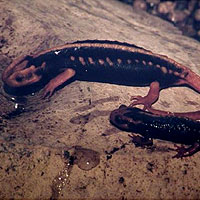Amphibians - Crocodile Newt
 Region:
Indomalaya Region:
Indomalaya
Class: Amphibia
Order: Caudata
Family: Salamandridae
Genus: Tylototriton
Scientific Name: Tylototriton shanjing
Description: Length: 15.24 - 20.32 cm. The Crocodile newt
is also called the Emperor newt or Mandarin salamander.
The vivid dorsal colouration of a dazzling orange vertebral
stripe culminating in a completely orange tail with 12
- 14 orange round protuberances along the ribs on a black,
dark brown or maroon background. It is considered to be
mainly nocturnal and this is thought to be due to the
fact that certain water snakes and raptors prey on them
without displaying any adverse effects from the harmful
alkaloids contained in their bodies. Males tend to be
smaller than the females, are more streamlined, have somewhat
thicker forearms and have a much more swollen cloaca.
They are largely terrestrial during the non-productive
periods and are not particularly adept swimmers although
they do enjoy bathing.
Distribution: Mountains of western China (primarily in
the Himalayan subregion of western Yunan), Burma, extreme
northeast India, northern Thailand (where it is believed
to be extinct) and Nepal.
Habitat: Cool woodland and forest usually in the vicinity
of slow-moving water.
Food: Insects
Reproduction and Development: Mating usually takes place
in water a few weeks after a dormancy period from December
to March. Fertilization is external with the male dropping
up to three small cone shaped spermatophores which he
then drags the female’s cloaca across. There is a
7 - 21 day ova development period then the female searches
in the water for a suitable egg laying site. Eggs are
usually adhered to the side of a partially submerged rock
in clumps of 10 - 15 with the normal quantity being 40
- 60 in total. Eggs are 2mm in diameter with a yellowish
nucleus. The larvae hatch in 10 - 18 days and measure
approximately 9mm in length. They are very slow developers
and take 110 - 150 days to metamorphose. On metamorphosing
they measure 4.93 - 6.35cm reaching maturity in the second
or third year.
Adaptations: The newt’s colouration makes it very
conspicuous so this would appear to make it vulnerable
to predation. However apart from it being shy, it’s
skin contains some distasteful and potentially harmful
alkaloids. Also the skull and upper vertebrae are heavily
armoured with additional layers of thick bone which serve
to deter predators. Their brilliant colouration actually
enables the newt to bath in the open during the day where
shifting reflections of light against the pebbled stream
beds enables cryptic colouration i.e. colours are broken
up so that they merge with the colours of the pebbles.
Threats: Until recently Crocodile newts were imported
into Europe and the US from specimens caught in the wild
in Thailand. 10,000 were exported from this region alone
in 1992. Since then strict laws have limited the collection
of this species from the wild.
Status: Common
References: The Mandarin Salamander FAQ by Marc S. Staniszewski
(via the Internet) |
|
|
